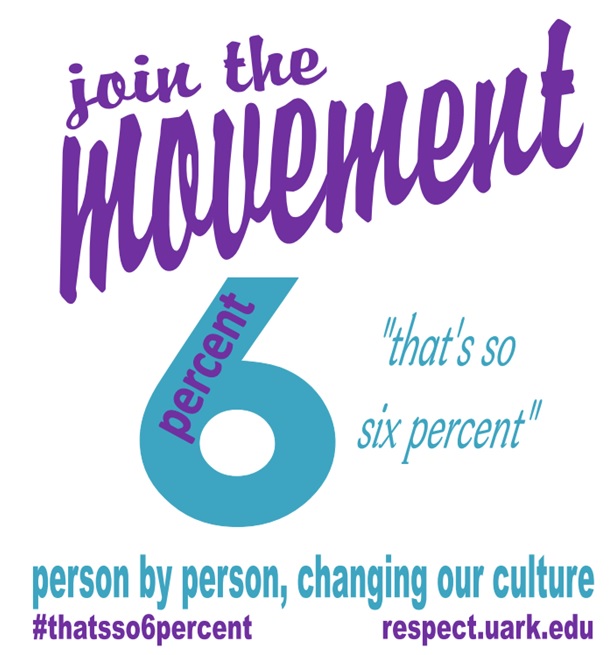That’s so 6%
That’s so 6% – Not Just a Saying, But a Movement
#thatsso6percent
The concept is really simple:
- About 1 in 4 women and 1 in 16 men are sexually assaulted while in college (Cantor, et al. 2015; Fisher, et al, 2000)
- Research indicates that it’s a small percentage who are responsible for perpetrating sexual assault among college students. Research indicates that the majority of these offenders are male, but overall, only a small percentage of males commit these offenses. In fact, in their original study, Lisak and Miller (2002) found that 6% of college men are responsible for the vast majority of sexual assaults among college students.
- A more recent study suggests a total of 10.8% of college men perpetrate the majority of rapes among college students (Swartout, et al. 2015)
- Regardless of the exact percent, the original study by Lisak and Miller (2002) has provided insight about sexual violence and its perpetration among college students. Picking apart at numbers only distracts that there is a big problem being committed by a small number and some perpetrators are repeat offenders.
- So, fundamentally speaking, a small number of perpetrators of sexual assault are causing a huge problem for many students on America’s college campuses.
- Compounding this, we live in a culture that blames victims for their rapes through widespread acceptance of rape myths and normalization of sexualized violence. By default, our culture often results in the overlooking of sexual violence coupled with low accountability and convictions of sexual assault perpetrators.
- Everyday examples of rape culture are pervasive. But, seldom does anyone call it out.
- Examples include:
- rape myths
- misogynistic jokes
- rigid gender-based stereotypes
- inequalities and devaluing of people as they are categorized into groups
- widespread sexualized violence throughout various genres of media
- acceptance of sexist language or misuse of terms that devalue individuals and sexual violence (e.g. I “raped” that test.)
- and more…..
- Examples include:
- The most common reason that was given to us as to why students don’t call out every day examples of rape culture is because they “just didn’t want to get into it.”
- We understand it is difficult to be among the first to speak out with something that is counter-cultural.
- So, considering the original study that started a serious look at who is actually committing sex offenses on college campuses and that rape culture serves no purpose other than to distract from offenses of sexual violence, we encourage you to consider calling out rape culture with “that’s so 6%”.
- In other words, that sexist joke (or:gender-based derogatory slang term, misogynistic social media post, inappropriate use of the word rape, sexist gesture, sexual objectification, etc) is something that lines up more with what the 6% would think was okay
- Do you really want to give more power to those who commit sex offenses? Let’s do better than that!
- Let’s call out rape culture for what it is…..#thatsso6percent
- In other words, that sexist joke (or:gender-based derogatory slang term, misogynistic social media post, inappropriate use of the word rape, sexist gesture, sexual objectification, etc) is something that lines up more with what the 6% would think was okay
- By calling out rape culture for what it is with four simple words, there is no need to “get into it.” Quite the contrary. For those already familiar with what “that’s so 6%” means, they get it and nothing more needs to be said. For those unfamiliar with what “that’s so 6%” means, we have observed these four words igniting a meaningful dialogue about its movement to counter rape culture rather than a confrontation.
Be the cultural change and say “that’s so 6%.”
References:
- Cantor, D., Fisher, B., Chibnall, S., Townsend, R., Lee, H., Bruce, C., & Thomas, G. (2015). Report on the AAU campus climate survey on sexual assault and sexual misconduct. Retrieved on December 14,, 2015 from https://www.aau.edu/uploadedFiles/AAU_Publications/AAU _Reports/Sexual_Assault_Campus_Survey/AAU_Campus_Climate_Survey_12_14_15.pdf
- Fisher, B. S., Cullen, F. T., & Turner, M. G. (2000). The sexual victimization of college women. (NCJ 182369). Rockville, MD: National Criminal Justice Reference Service.
- Lisak, D. and Miller, P.M. (2002). Repeat rape and multiple offending among undetected rapists. Violence and Victims, 17(1), 73-84.
- Swartout, K. M., Koss, M. P. White, J. W., Thompson, M. P., Abbey, A. & Bellis, A. L. (2015). Trajectory Analysis of the Campus Serial Rapist Assumption. JAMA Pediatric, 169(12), 1148-1154.

